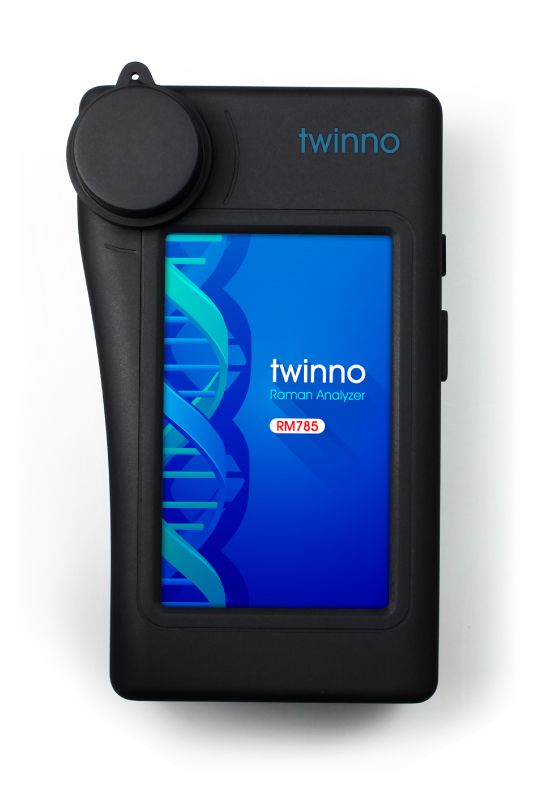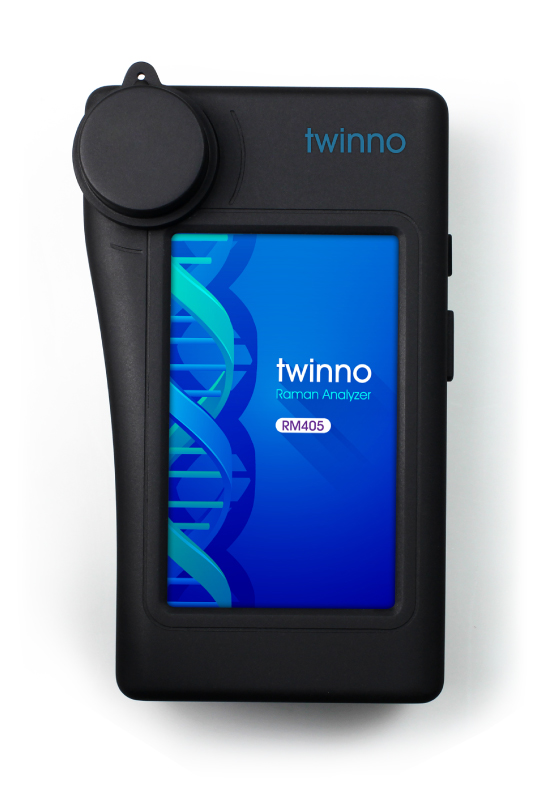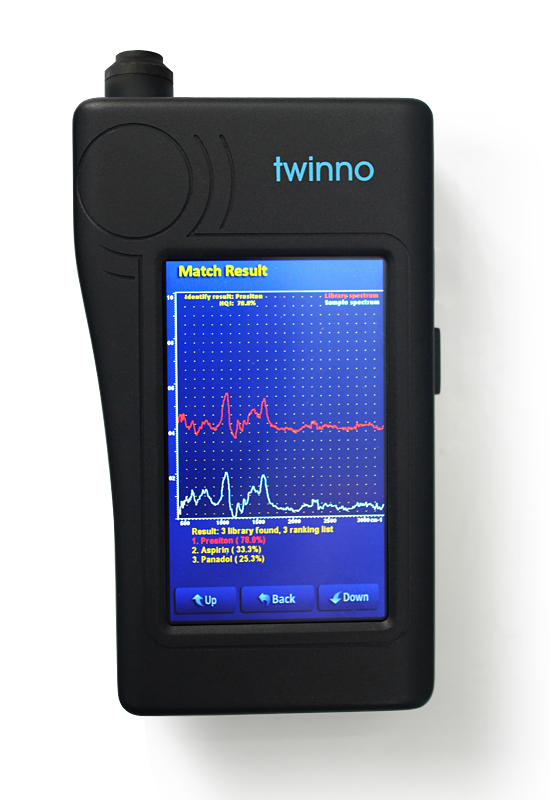Raman analyzer
拉曼散射 Raman scattering
In 1928, Indian scientists C. V. Raman use a narrowband filter and sunlight to create a monochromatic light. He discovered that when light traverses a transparent material, some of the deflected light changes in wavelength, This phenomenon was then termed as the raman scattering.
Raman spectroscopy is a light scattering technique, a photon of incident interacts with a sample to produce scattered light, most of the scattered light and incident light having the same wavelength, known as Rayleigh scattering. Also, the wavelength of a small amount of scattered light is different from the incident light, it's intensity of scattered light is about 10-7, which changes the wavelength determined by the chemical structure of the scattering material, known as Raman scattering.
1928年,印度科学家C. V. Raman利用太阳光和一个窄带滤波器制造出单色光。他发现光穿过一个透明的物质,一些偏转光的波长改变,此现象被称为拉曼效应。 拉曼光谱是一种光散射技术,入射光子和样品相互作用产生了散射光子,大多数散射光与入射光具有相同的波长,称为瑞利散射。还有极小一部分散射光的波长与入射光不同,散射光强度大约是总散射光强度的10-7,其波长的改变由散射物质的化学结构所决定,称为拉曼散射。
1928年,印度科学家C. V. Raman利用太阳光和一个窄带滤波器制造出单色光。他发现光穿过一个透明的物质,一些偏转光的波长改变,此现象被称为拉曼效应。 拉曼光谱是一种光散射技术,入射光子和样品相互作用产生了散射光子,大多数散射光与入射光具有相同的波长,称为瑞利散射。还有极小一部分散射光的波长与入射光不同,散射光强度大约是总散射光强度的10-7,其波长的改变由散射物质的化学结构所决定,称为拉曼散射。
拉曼光谱原理 Theory of Raman
The spontaneous raman effect is the incident photon exciting the molecule from ground state into a virtual energy state, When the virtual energy state emit a photon and relax back down to the ground state is different from a rotating or vibrating state, the difference in energy between the ground state and the virtual energy state leads to a shift in the emitted photon's frequency away from the excitation wavelength.
If the final vibrational state of the molecule is more energetic than the initial state, the inelastically scattered photon will be shifted to a lower frequency for the total energy of the system to remain balanced. This shift in frequency is designated as a Stokes shift. If the final vibrational state is less energetic than the initial state, then the inelastically scattered photon will be shifted to a higher frequency, and this is designated as an anti-Stokes shift. Stokes shift is the larger raman scattering, Due to the fact that most molecules will be found in the ground state at room temperature.
自發拉曼效應是光子將分子從基態激發到一個虛擬的能量狀態,當激發態的分子放出一個光子後並返回到一個不同於基態的旋轉或振動狀態,在基態與新狀態間的能量差會使得釋放光子的頻率與激發光的不同。如果最終振動狀態的分子比初始狀態時能量高,所激發出來的光子頻率則較低,以確保系統的總能量守衡。這一個頻率的改變被稱為史托克位移。如果最終振動狀態的分子比初始狀態時能量低,所激發出來的光子頻率則較高,這一個頻率的改變被稱為反史托克位移。史托克位移的拉曼散射強度較大,這是因為大部分分子將在室溫下的基態中找到。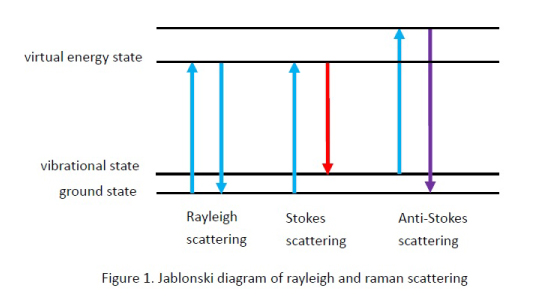
自發拉曼效應是光子將分子從基態激發到一個虛擬的能量狀態,當激發態的分子放出一個光子後並返回到一個不同於基態的旋轉或振動狀態,在基態與新狀態間的能量差會使得釋放光子的頻率與激發光的不同。如果最終振動狀態的分子比初始狀態時能量高,所激發出來的光子頻率則較低,以確保系統的總能量守衡。這一個頻率的改變被稱為史托克位移。如果最終振動狀態的分子比初始狀態時能量低,所激發出來的光子頻率則較高,這一個頻率的改變被稱為反史托克位移。史托克位移的拉曼散射強度較大,這是因為大部分分子將在室溫下的基態中找到。

拉曼光谱应用 Applications of Raman
Raman spectrum is commonly used in chemistry, since vibrational information is specific to the chemical bonds and symmetry of molecules. It provides a fingerprint by which the molecule can be identified. Raman spectrum is a very efficient and non-destructive method for analysis of a wide range of materials and system.
拉曼光谱(Raman)中的讯号提供了化学键、官能基的信息, 也可以用来确认结构信息 (例如: 甲、乙醇的化学结构差异), 手持式拉曼光谱仪, 设计了复杂的光学路径与组件, 利用雷射光源照射在样品表面上, 即得到光谱信息, 再利用仪器内部的数据库比对物质分析结果。
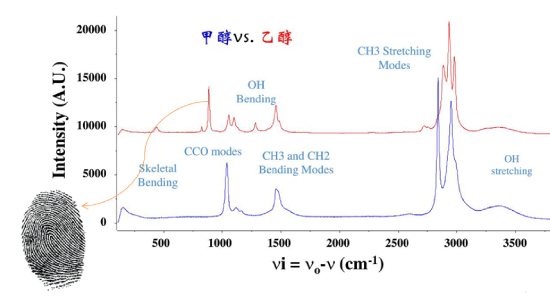
拉曼光谱(Raman)中的讯号提供了化学键、官能基的信息, 也可以用来确认结构信息 (例如: 甲、乙醇的化学结构差异), 手持式拉曼光谱仪, 设计了复杂的光学路径与组件, 利用雷射光源照射在样品表面上, 即得到光谱信息, 再利用仪器内部的数据库比对物质分析结果。

